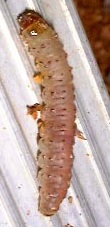 Sequoia Pitch Moth in Pines - May 22, 2013 Jeff Schalau, Agent, Agriculture & Natural Resources University of Arizona Cooperative Extension, Yavapai County Following droughty winter periods, Verde Valley residents often call Yavapai County Cooperative Extension about their declining and/or dying pine trees in residential and commercial landscapes. The most common cause is improper or nonexistent irrigation. Having green foliage year-round increases the need for supplemental irrigation during winter – even with the most drought tolerant pines. Other factors such as insects and diseases can also increase stress on pine trees. One of our common pine pests is the sequoia pitch moth (Synanthedon sequoiae). Although not usually harmful to a healthy tree, pitch moths can cause visible signs that cause owners distress and concern. After reading this column, you should be able to recognize this insects’ damage and understand when and if management is necessary. While pesticides are not recommended for sequoia pitch moth management, some cultural practices can reduce its impact on your pine trees. As with many Lepidopteran (moth and butterfly) pests, the caterpillar or larva is the life stage that causes plant damage. They rarely kill the trees they attack. However, the large quantity of milky pitch gets the attention of homeowners. It appears as a raised mound of sap and sawdust on the side of the trunk often near a branch. The pitch masses can be gray, pink, reddish, or yellowish and protrude from infested trunks and limbs. Old pitch masses can remain on bark for several years and these abandoned pitch masses are often reinfested because egg-laying females are attracted to injury sites. Mondell (also called Quetta, Goldwater, or Afghanistan), Aleppo, Japanese black, pinyon, and ponderosa pines are all susceptible to sequoia pitch moth colonization. The adult sequoia pitch moth flies during daylight hours and somewhat resembles a wasp. Its wings are mostly transparent with bluish black edges. It has yellow stripes on its abdomen causing it to resemble a wasp or yellow jacket. Peak moth flights occur during June and July but can occur anywhere between May and September. Females lay eggs individually on and in tree bark of pine species. They prefer laying eggs near wounds or fresh pruning cuts. Eggs hatch within two weeks. Once inside, the larva feeds on the cambium layer just beneath the bark. The pinkish gray larva feeds for several months and is about ¾ inch long when mature. The larva pupates for about one month. As the pupa matures, it pushes itself through the pitch mass until it is half exposed. Some moths may emerge from the pupa case within a year, but most will require 2 years from egg to mature moth spending the bulk of the life cycle in the larval stage. People unfamiliar with the damage may confuse pitch moth masses with bark beetle pitch tubes. Bark beetle pitch tubes are usually less than 1/2 inch in diameter and typically have a distinct round hole in the center made by an adult beetle. Sequoia pitch moth masses are much larger and vary in shape from roundish to an elongated oval. Cultural controls can be effective in decreasing pith moth damage. Prune pines only when necessary, and then, only between October and February. This will minimize attraction and damaged areas that promote easy entry by newly hatched larvae. In addition, NEVER use line trimmers (weed eaters) around the bases of trees. Girdling caused by these machines can kill a tree in addition to attracting pitch moths. The best management strategy is to keep pine trees healthy. Irrigate them during dry periods and watch for new pitch masses. Conversely, you should be aware that pine trees could easily be over watered. If curiosity gets the best of you, you can dig the larva out with a pocketknife and examine the damage. The larva is usually just below the pitch mass. There is generally one larva per pitch mass and after doing this messy task once, you are not likely to repeat it. It’s okay, healthy pine trees can tolerate multiple pitch moth larvae without any trouble. Additional sequoia pitch moth information and photos are included below. Follow the Backyard Gardener on Twitter – use the link on the BYG website. If you have other gardening questions, call the Master Gardener help line in the Camp Verde office at 928-554-8999 Ext. 3 or e-mail us at cottonwoodmg@yahoo.com and be sure to include your name, address and phone number. Find past Backyard Gardener columns or provide feedback at the Backyard Gardener web site: http://cals.arizona.edu/yavapai/anr/hort/byg/. Additional Information and Photos Sequoia Pitch Moth, University of California IPM On-Line http://www.ipm.ucdavis.edu/PMG/PESTNOTES/pn7479.html |